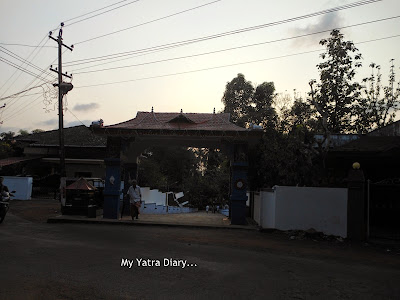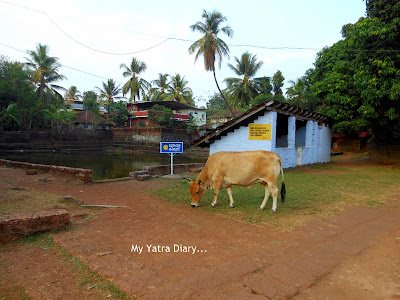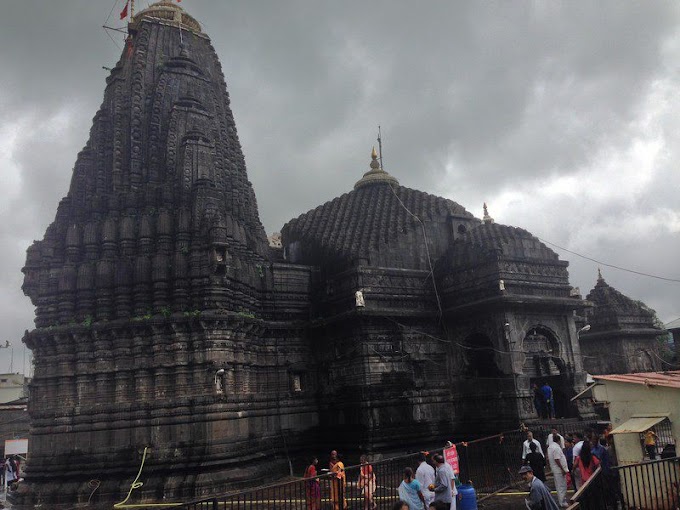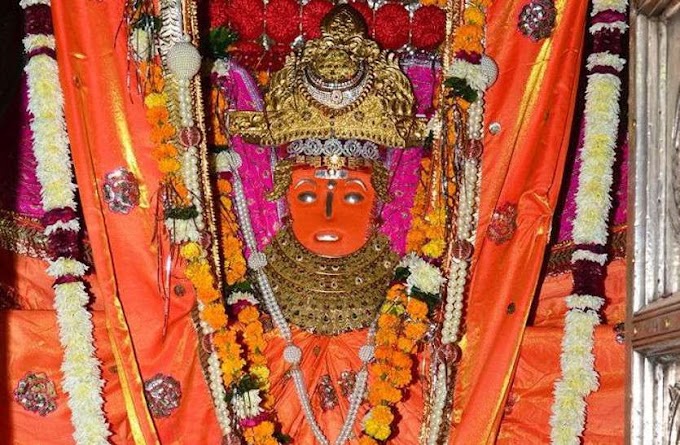Around 20 km from the town of Kannur in Kerala, 5 kms south of Taliparambu town and a short drive of around 15 minutes from Shree Muthappan Temple, is situated the Trichambaram temple.
Entrance to the Trichambaram Temple compound
Descend a fleet of stairs and you are led to the temple compound in the center of which stands the main temple. Dedicated to Lord Shree Krishna in his child avatar, the Trichambaram temple, like majority of temples in Kerala, exudes a high degree of calm and serenity the moment you enter its blissful shade.
A pair of weighing scales in the temple compound
The main Trichambaram temple
Long strings of Tulsi malas and scores of non lit deepams line the way to the sanctum sanctorum. The sanctum is bright intensely lit up with a multitude of deepams all around and the Lord seated comfortably in the center. A huge bell hangs at the outside but the priest discourages me to ring it the moment he sees me lifting my hand towards it. I am a bit surprised but soon reason it for myself: Peace here is left to be just that... peace – untouched and undisturbed.
Trichambaram temple from the outside
The aura of the flickering lights emanating from inside the sanctum works magic with the peace spread all around. And one has to take it in before moving forward to the circumambulation path which reveals the antiquity of the temple in all its glory. The outsides of the sanctum walls flourish in ancient paintings depicting various leelas of Lord Shri Krishna and dating back to the 15th century, a compelling reassurance of the rich historical value of the temple.
Outside, in the shadows of the main temple stands another shrine encircled by a small pond and dedicated to Goddess Durga.
Goddess Durga temple in the compound
Besides this shrine is a second pond, a great place to spend a few minutes in contemplation along with a grazing cow before finally making my way out of the temple.
A cow happily grazing near the temple pond
Traveler tips and Information:
Dress code: Mundu (white cloth or cream cloth attire also called as Veshti in Tamil) is a mandatory clothing for men who wish to enter the temple. Though it is advisable to carry it with you but in case you don’t, it can be brought from a shop inside the temple. (Tip: Shop remains closed from 12 – 5 in the afternoon.)
Photography: is prohibited inside.
Festival: The annual festival of the temple is the Trichambaram Mahotsavam, a vivid occasion usually held in the months February/March.
Dress code: Mundu (white cloth or cream cloth attire also called as Veshti in Tamil) is a mandatory clothing for men who wish to enter the temple. Though it is advisable to carry it with you but in case you don’t, it can be brought from a shop inside the temple. (Tip: Shop remains closed from 12 – 5 in the afternoon.)
Photography: is prohibited inside.
Festival: The annual festival of the temple is the Trichambaram Mahotsavam, a vivid occasion usually held in the months February/March.












39 Comments
A long while since I've been on my virtual travels with you, as always its been a delight.
ReplyDeleteA serene and holy place; I can tell from just the pictures.
ReplyDeletehi arti...loved your post but just wanted to tell you something regarding dress code, its not "lungi" it is called as "Mundu"....lungi is casual wear which is not allowed inside any temples in kerala dear....may be you got the name wrong...mundu is white cloth or cream cloth attire also called as "Veshti"in tamil :)
ReplyDeleteThank you very much Divya for the heads-up. Very much appreciated. I will correct this right away. :)
DeleteThank you arti...that was sweet
DeletePic of Mundu or veshti
ReplyDeletehttp://en.wikipedia.org/wiki/Mundu
The little mini shrines are so cute, and I can see the coy in the pond. The yellow columns are very pretty, yellow being a spiritual color.
ReplyDeleteLovely pictures from Kerala. I have always enjoyed the natural beauty of the place but seldom been to temples. The practice of forcing people to wear a particular dress is something that drives me away from most Kerala temples.
ReplyDeletePeace- just that and itself. I could almost hear the joyful silence.
ReplyDeletecalm and serenity is an essential characteristic of all Kerala temples as you have rightly said. They provide an opportunity to establish oneness with the presiding deity. This is what appeals me.
ReplyDeleteParasannikadavu could have been noisy.
I agree. The peace helps us get closer to the supreme and this factor is something that pulls me to visit the state again sometime in the near future. Yes, Parasannikadavu was a little more crowded than this one perhaps because it is more famous with the locals and it also boasts of theyyam performance two times in the day.
DeleteArti, Another awesome post from your yatra. Great to read, Thanks for sharing. Beautiful photographs and description.
ReplyDeleteinteresting post with great info and photographs
ReplyDeletethanks arti
Arti it's realy peacefuly place. What i love more about the temple around south is they have strick rule, and keep the temple inside not as tourist destination, but realy a place for pray :)
ReplyDeleteSimply awesome photos complemented by some breath taking text... great
ReplyDeleteWhat a beautiful place to visit.
ReplyDeleteLooks like a very serene and calm atmosphere. Thanks for introducing this little known temple.
ReplyDeletehttp://rajniranjandas.blogspot.in/2013/06/amidst-sea-of-blue.html
Its been years since I visited this temple. and this post brought back loads of memories!
ReplyDeleteTrichambaram temple looks so peaceful, even the water in the pond is so calm and reflective.
ReplyDeleteBeautiful shots. The cow is so relax. :)
ReplyDeleteYour gorgeous pictures and the write-up makes me miss Kerala all the time .... sob sob sob :(
ReplyDeleteBut am extremely delighted to revisit your space over n again to refresh those memories....
I havent been to the temple. Infact havent been to Kannur also. I am from the other part of Kerala, Arti (from Quilon), around 2 hrs from Trivandrum.. But I can tell you the temples in Kerala are very beautiful and well maintained..
ReplyDeleteAbsolutely quiet and calm temple complex! Beautiful photos and I like the tank areas.
ReplyDeleteSuch a serene place. Wish photography is allowed inside.
ReplyDeleteI think this temple seems to be different from Japanese, bright color, but so calm and peace.
ReplyDeleteHave a lovely day!
Wonderful temple and nice pictures .
ReplyDeleteI'm guessing that all the greenery and visits to these temples totally recharged you. Don't temples in Kerala have a smell of their own :)?
ReplyDeleteAarti... this was exactly what I needed to pep me up on a bad day - memories from my childhood!! I grew up a few kilometers from this very temple. Also do visit the Perlassery Subramanya temple .... would love to see a post on that as well. Thank you!!
ReplyDeleteI love that shrine encircled by a small pond...the cow grazing looks so content and emanates a peaceful aura...I can feel the serenity in the place..and your words as always conveyed the beauty of the place so meaningfully...:)
ReplyDeleteWonderful post on Temples! This is the reason I like your blog :)
ReplyDeleteSerene.. Feel like visiting..Kerala is long pending in my agenda..
ReplyDeleteWonderful post... Nice photographs..
ReplyDeletebeautiful temple , small pond
ReplyDeleteLoved your pics and as usual your short and simple way of taking us on a journey :)
ReplyDeleteThis temple has more muted colors than all the other colorful temples on your blog which are much more colorful than Japanese temples of unpainted wooden structure. Is dress code to enter the temple only for men?
ReplyDeleteThank you for the lovely and kind comment. After long days of dry rainy season, it rained yesterday at last and occasional rain is forecasted on Wednesday and Thursday. It has been too hot for June and I wish rain softens the heat. Be safe from torrential rain, Arti.
Yoko
The color difference that you see is because of the difference in the regions. This temple belongs to the southern part of India while most of the other temples on my blog (from earlier series) are from northern India. Hence, they are different, in look and even in architecture. The dress code is only for Men in this temple, however many temples in Kerala do follow a strict dress rule for both men and women.
DeleteThank you, Yoko for your kind visit and comment. I hope Nara has sufficient rains this season, the weather in my part has been quite harsh for the past few days.
I didn't know about the color difference. Could you explain a little more?
Deleteu should publish this temples inner god images i think
ReplyDeleteYou go to Kerala temple to pray to Lord. You enter the temple with reverence.Your mind, body and clothes should be clean when you go to temple. Each region has its own customs, practices and traditions. We have to respect it. So when you go to kerala temple men wear Veshti ( mundu) and women wear "settu mundu" .This was the practice for centuries. Now a days women also wear sarees and salwar kameez or churidar too.
ReplyDeleteRinging the bell is the exclusive preserve of the chief priest at appropriate times. You will find that the priests in Kerala temples are very devoted and disciplined. Their day starts at 4.00A.M.( brahma muhurtham) and they take their first food only after Ucha pooja( that is Pooja for the Lord before noon) which in most temples are around 11.30A.M.
Going to temple should not be considered as sight seeing trip or excursion. Please try to preserve the serenity and sanctity of kerala temples.
Krishnan
Delighted you stopped by... Your suggestions, feedback are really appreciated. Thanks a lot :) Hope you visit again!
If you have asked a question, please give me at least 2 days to reply back. Thank you :)